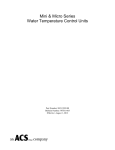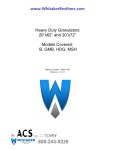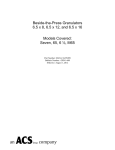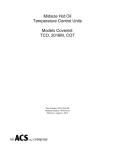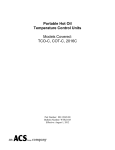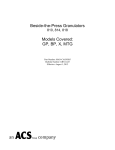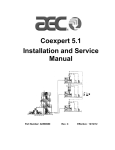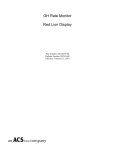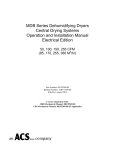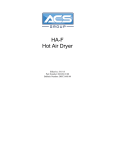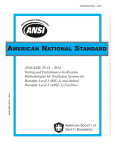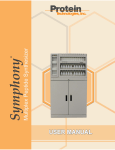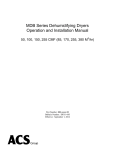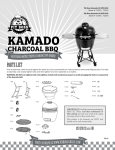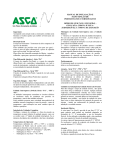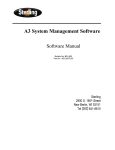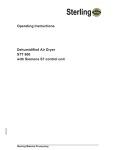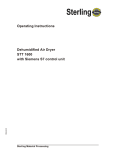Download User Guide - ACS Group
Transcript
Compact and Upright Water Temperature Control Units Models Covered: TrueTemp TCU, CWT, Royal Series 2010/2012 Part Number: 882.12041.00 Bulletin Number: WTR1-605 Effective: August 1, 2012 Write Down Your Serial Numbers Here For Future Reference: _________________________ _________________________ _________________________ _________________________ _________________________ _________________________ We are committed to a continuing program of product improvement. Specifications, appearance, and dimensions described in this manual are subject to change without notice. DCN No. ____________ © Copyright 2012 All rights reserved. Page 2 Compact and Upright Water Temperature Control Units Shipping Info Unpacking and Inspection You should inspect the water temperature control unit for possible shipping damage. Thoroughly check the equipment for any damage that might have occurred in transit, such as broken or loose wiring and components, loose hardware and mounting screws, etc. In the Event of Shipping Damage According to the contract terms and conditions of the Carrier, the responsibility of the Shipper ends at the time and place of shipment. Notify the transportation company’s local agent if you discover damage. Hold the damaged goods and packing material for the examining agent’s inspection. Do not return any goods before the transportation company’s inspection and authorization. File a claim with the transportation company. Substantiate the claim by referring to the agent’s report. A certified copy of our invoice is available upon request. The original Bill of Lading is attached to our original invoice. If the shipment was prepaid, write us for a receipted transportation bill. Advise customer service regarding your wish for assistance and to obtain an RMA (return material authorization) number. If the Shipment is Not Complete Check the packing list as back-ordered items are noted on the packing list. You should have: þ Water Temperature Control Unit þ Bill of lading þ Packing list þ Operating and Installation packet þ Electrical schematic and panel layout drawings þ Component instruction manuals Re-inspect the container and packing material to see if you missed any smaller items during unpacking. If the Shipment is Not Correct If the shipment is not what you ordered, contact the shipping department immediately. For immediate assistance, please contact the correct facility located in the technical assistance section of this manual. Have the order number and item number available. Hold the items until you receive shipping instructions. Compact and Upright Water Temperature Control Units Page 3 Returns Do not return any damaged or incorrect items until you receive shipping instructions from the shipping department. Credit Returns Prior to the return of any material authorization must be given by the manufacturer. A RMA number will be assigned for the equipment to be returned. Reason for requesting the return must be given. ALL returned material purchased from the manufacturer returned is subject to 15% ($75.00 minimum) restocking charge. ALL returns are to be shipped prepaid. The invoice number and date or purchase order number and date must be supplied. No credit will be issued for material that is not within the manufacturer’s warranty period and/or in new and unused condition, suitable for resale. Warranty Returns Prior to the return of any material, authorization must be given by the manufacturer. A RMA number will be assigned for the equipment to be returned. Reason for requesting the return must be given. All returns are to be shipped prepaid. The invoice number and date or purchase order number and date must be supplied. After inspecting the material, a replacement or credit will be given, at the manufacturer’s discretion. If the item is found to be defective in materials or workmanship, and it was manufactured by our company, purchased components are covered under their specific warranty terms. Page 4 Compact and Upright Water Temperature Control Units Table of Contents Shipping Info .............................................................................................................. 3 Chapter 1:Safety .............................................................. 7 1-1 How to Use This Manual ................................................................................... 7 Safety Symbols Used in this Manual ................................................................... 8 1-2 Warnings and Precautions ................................................................................ 9 1-3 Responsibility .................................................................................................. 10 Chapter:2 2-1 2-2 2-3 2-4 2-5 Functional Description ............................ 14 Introduction ..................................................................................................... 14 Necessary Documents .................................................................................... 15 Models Covered .............................................................................................. 15 Standard TCU Series Features....................................................................... 15 Available Options ............................................................................................ 16 Chapter:3 Installation ................................................ 20 3-1 Installation Location Considerations ............................................................... 20 3-2 Process Approach Temperature Considerations ............................................ 20 3-3 External Piping Sizing Considerations ............................................................ 20 3-4 Piping Considerations for Permanent Installations ......................................... 21 3-5 Piping Considerations for High Mobility Installations ...................................... 22 3-6 Process Water Considerations ....................................................................... 22 3-7 Making Process Water Connections ............................................................... 23 3-8 Making Cooling Water Connections................................................................ 24 3-9 Making System Purge Connections ................................................................ 25 3-10 Making Electrical Connections ....................................................................... 27 Chapter:4 Identifying Controls and Features.......... 30 4-1 Identifying Mechanical Controls and Features ................................................ 30 4-2 Motorized Modulating Valves ......................................................................... 32 4-3 Water Hammer Arrestor (Shock Stop) ............................................................ 32 4-4 The Microprocessor Controller........................................................................ 33 4-5 Controller Display............................................................................................ 34 4-6 Digital Flow Meter ........................................................................................... 35 4-7 Identifying Graphic Panel Indicators ............................................................... 36 4-8 Using Graphic Panel Buttons .......................................................................... 38 4-9 Alarms ............................................................................................................. 39 4-10 Controller Internal Switches ........................................................................... 39 4-11 Communications ............................................................................................ 39 Chapter:5 Startup and Operation ............................. 40 5-1 Introduction ..................................................................................................... 40 5-2 Startup Checklist ............................................................................................. 40 Compact and Upright Water Temperature Control Units Page 5 5-3 5-4 5-5 5-6 Starting the Temperature Control Unit ............................................................ 41 Sequence of Operation ................................................................................... 42 Checking Motor Rotation Direction ................................................................. 43 Shutting Down the Temperature Control Unit ................................................. 43 Chapter:6 6-1 6-2 6-4 6-5 6-6 Unit Maintenance ..................................... 45 Preventive Maintenance ................................................................................. 45 Corrective Maintenance .................................................................................. 46 Electrical Connections .................................................................................... 48 Safety Devices ................................................................................................ 48 Cleaning and Storage ..................................................................................... 51 Chapter:7 Troubleshooting....................................... 52 Technical Assistance ............................................................................................... 57 Parts and Service Department ............................................................................ 57 Sales and Contracting Department..................................................................... 57 Page 6 Compact and Upright Water Temperature Control Units Chapter 1:Safety 1-1 How to Use This Manual Use this manual as a guide and reference for installing, operating, and maintaining the water temperature control unit. The purpose is to assist you in applying efficient, proven techniques that enhance equipment productivity. This manual covers only light corrective maintenance. No other maintenance should be undertaken without first contacting a service engineer. The Functional Description section outlines models covered, standard features, and safety features. Additional sections within the manual provide instructions for installation, pre-operational procedures, operation, preventive maintenance, and corrective maintenance. The Installation chapter includes required data for receiving, unpacking, inspecting, and setup of the Compact and Upright Series temperature control unit. We can also provide the assistance of a factory-trained technician to help train your operator(s) for a nominal charge. This section includes instructions, checks, and adjustments that should be followed before commencing with operation of the temperature control unit. These instructions are intended to supplement standard shop procedures performed at shift, daily, and weekly intervals. The Operation chapter includes a description of electrical and mechanical controls, in addition to information for operating the temperature control unit safely and efficiently. The Maintenance chapter is intended to serve as a source of detailed assembly and disassembly instructions for those areas of the equipment requiring service. Preventive maintenance sections are included to ensure that the temperature control unit provides excellent, long service. The Troubleshooting chapter serves as a guide for identification of most common problems. Potential problems are listed, along with possible causes and related solutions. The Appendix contains technical specifications, drawings, schematics, parts lists, and available options. A spare parts list with part numbers specific to your machine is provided with your shipping paperwork package. Refer to this section for a listing of spare parts for purchase. Have your serial number and model number ready when ordering. Compact and Upright Water Temperature Control Units Page 7 Safety Symbols Used in this Manual The following safety alert symbols are used to alert you to potential personal injury hazards. Obey all safety messages that follow these symbols to avoid possible injury or death. DANGER indicates an imminently hazardous situation that, if not avoided, will result in death or serious injury. WARNING indicates a potentially hazardous situation or practice that, if not avoided, could result in death or serious injury. CAUTION indicates a potentially hazardous situation or practice that, if not avoided, may result in minor or moderate injury or in property damage. Temperature control unit Safety Tags Hazard Alert Symbol Mandatory Symbol Description/Explanation Preventative Maintenance High Voltage Hazard. The electrical enclosure is supplied with 3-phase electrical power. Use caution when using or maintaining this product. Hot Surface Hazard. When the unit operates above 212F (100C) the surface of the unit may reach excessive temperatures. Use caution when using or maintaining this product. Every six months inspect all electrical connections for secure attachment. For further information see the Maintenance Chapter in this manual Every six months inspect all surfaces for signs of heat degradation. If any appear remove panel and verify cause of degradation and repair. Description/Explanation Read Operators Manual. This equipment must be operated and maintained by properly trained personnel. The information contained within this manual must be read and understood prior to operating this equipment. Lock Out. This equipment is operated with 3-phase electrical power. Therefore, when performing any maintenance operations we recommend following the local standards for performing a lock-out/tag-out procedure. Wear Safety Gloves. This equipment operates above 212F (100C) and its surfaces may reach excessive temperatures. We recommend that technicians use safety gloves while performing maintenance to protect hands from being exposed to these hot surfaces. Page 8 Compact and Upright Water Temperature Control Units 1-2 Warnings and Precautions Our equipment is designed to provide safe and reliable operation when installed and operated within design specifications, following national and local safety codes. This may include, but is not limited to OSHA, NEC, CSA, SPI, and any other local, national and international regulations. To avoid possible personal injury or equipment damage when installing, operating, or maintaining this equipment, use good judgment and follow these safe practices: þ Read and follow these operation and installation instructions when installing, operating, and maintaining this equipment. If these instructions become damaged or unreadable, additional copies are available from the manufacturer. þ Follow all SAFETY CODES. þ Wear SAFETY GLASSES and WORK GLOVES. þ Work only with approved tools and devices. þ Disconnect and/or lock out power before servicing or maintaining the equipment. þ Use care when LOADING, UNLOADING, RIGGING, or MOVING this equipment. þ Operate this equipment within design specifications. þ OPEN, TAG, and LOCK ALL DISCONNECTS before working on equipment. You should remove the fuses and carry them with you. þ Make sure the equipment and components are properly GROUNDED before you switch on power. þ When welding or brazing in or around this equipment, make sure VENTILATION is ADEQUATE. PROTECT adjacent materials from flame or sparks by shielding with sheet metal. An approved FIRE EXTINGUISHER should be close at hand and ready for use if needed. þ Do not restore power until you remove all tools, test equipment, etc., and the equipment and related components are fully reassembled. þ Only PROPERLY TRAINED personnel familiar with the information in this manual should work on this equipment. We have long recognized the importance of safety and have designed and manufactured our equipment with operator safety as a prime consideration. We expect you, as a user, to abide by the foregoing recommendations in order to make operator safety a reality. Compact and Upright Water Temperature Control Units Page 9 1-3 Responsibility These machines are constructed for maximum operator safety when used under standard operating conditions and when recommended instructions are followed in the maintenance and operation of the machine. All personnel engaged in the use of the machines should become familiar with their operation as described in this manual. Proper operation of the machine promotes safety for the operator and all workers in its vicinity. Each individual must take responsibility for observing the prescribed safety rules as outlined. All warning and danger signs must be observed and obeyed. All actual or potential danger areas must be reported to your immediate supervisor. General Responsibility No mater who you are, safety is important. Owners, operators and maintenance personnel must realize that every day, safety is a vital part of their jobs. If your main concern is loss of productivity, remember that production is always affected in a negative way following an accident. The following are some of the ways that accidents can affect your production: • Loss of a skilled operator (temporarily or permanently) • Breakdown of shop morale • Costly damage to equipment • Downtime An effective safety program is responsible and economically sound. Organize a safety committee or group, and hold regular meetings. Promote this group from the management level. Through this group, the safety program can be continually reviewed, maintained, and improved. Keep minutes or a record of the meetings. Hold daily equipment inspections in addition to regular maintenance checks. You will keep your equipment safe for production and exhibit your commitment to safety. Please read and use this manual as a guide to equipment safety. This manual contains safety warnings throughout, specific to each function and point of operation. Operator Responsibility The operator’s responsibility does not end with efficient production. The operator usually has the most daily contact with the equipment and intimately knows its capabilities and limitations. Plant and personnel safety is sometimes forgotten in the desire to meet incentive rates, or through a casual attitude toward machinery formed over a period of months or years. Your employer probably has established a set of safety rules in your workplace. Those rules, this manual, or any other safety information will not keep you from being injured while operating your equipment. Page 10 Compact and Upright Water Temperature Control Units Learn and always use safe operation. Cooperate with co-workers to promote safe practices. Immediately report any potentially dangerous situation to your supervisor. • NEVER place your hands or any part of your body in any dangerous location. • NEVER operate, service, or adjust the temperature control unit without appropriate training and first reading and understanding this manual. • NEVER try to pull material out of the temperature control unit with your hands while it is running! • Before you start the temperature control unit, check the following: • Remove all tools from the temperature control unit; • Be sure no objects (tools, nuts, bolts, clamps, bars) are laying in the area; • If your temperature control unit has been inoperative or unattended, check all settings before starting. • At the beginning of your shift and after breaks, verify that the controls and other auxiliary equipment are functioning properly. • Keep all safety guards in place and in good repair. NEVER attempt to bypass, modify, or remove safety guards. Such alteration is not only unsafe, but will void the warranty on your equipment. • When changing control settings to perform a different mode of operation, be sure selector switches are correctly positioned. Locking selector switches should only be adjusted by authorized personnel and the keys removed after setting. • Report the following occurrences IMMEDIATELY: • unsafe operation or condition • unusual temperature control unit action • leakage • improper maintenance • NEVER stand or sit where you could slip or stumble into the temperature control unit while working on it. • DO NOT wear loose clothing or jewelry, which can be caught while working on the temperature control unit. In addition, cover or tie back long hair. • Clean the temperature control unit and surrounding area DAILY, and inspect the machine for loose, missing or broken parts. • Shut off power to the temperature control unit when it is not in use. Turn the switch to the OFF position, or unplug it from the power source. Compact and Upright Water Temperature Control Units Page 11 Maintenance Responsibility Proper maintenance is essential to safety. If you are a maintenance worker, you must make safety a priority to effectively repair and maintain equipment. Before removing, adjusting, or replacing parts on a machine, remember to turn off all electric supplies and all accessory equipment at the machine, and disconnect and lockout electrical and pneumatic power. Attach warning tags to the disconnect switch and air shutoff valve. When you need to perform maintenance or repair work on a temperature control unit above floor level, use a solid platform or a hydraulic elevator. If there is a permanently installed catwalk on your temperature control unit, use it. The work platform should have secure footing and a place for tools and parts. DO NOT climb on the temperature control unit, machines, or work from ladders. If you need to repair a large component, use appropriate handling equipment. Before you use handling equipment (portable “A” frames, electric boom trucks, fork trucks, overhead cranes) be sure the load does not exceed the capacity of the handling equipment or cause it to become unstable. Carefully test the condition of lifting cables, chains, ropes, slings, and hooks before using them to lift a load. Be sure that all non-current carrying parts are correctly connected to earth ground with an electrical conductor that complies with current codes. Install in accordance with national and local codes. When you have completed the repair or maintenance procedure, check your work and remove your tools, rigging, and handling equipment. Do not restore power to the temperature control unit until all persons are clear of the area. DO NOT start and run the temperature control unit until you are sure all parts are functioning correctly. BEFORE you turn the temperature control unit over to the operator for production, verify all enclosure panels, guards and safety devices are in place and functioning properly. Reporting a Safety Defect If you believe that your equipment has a defect that could cause injury, you should immediately discontinue its use and inform the manufacturer. The principle factors that can result in injury are failure to follow proper operating procedures (i.e. lockout/tagout), or failure to maintain a clean and safe working environment. Page 12 Compact and Upright Water Temperature Control Units -Notes- Compact and Upright Water Temperature Control Units Page 13 Chapter:2 2-1 Functional Description Introduction The Compact and Upright Series water temperature control units are reliable, accurate, and easy-to-use process temperature control units. They are self-contained, portable, and shipped ready to use. The Compact and Upright Series water temperature control units are designed to circulate water through your process and to precisely, automatically, and reliably maintain it at a specified temperature. Standard unit operating range is from 0ºF (-17ºC) to 250°F (121°C), or up to 300°F (149°C) as an option. The unit is suited for use with city water, water from portable or central chillers or towers, or well water. These units are designed for rapid recirculation of a relatively small amount of water to provide close and uniform temperature relation between delivery and return lines. This performance, of course, depends on the configuration of your process and any restrictions within the mold. The recirculation, combined with the large immersion heater and cooling capability, gives fast and accurate response to bring the water up to temperature or to changes in the settings when needed. The water temperature control unit is a self-contained system consisting of a centrifugal pump, electric immersion heater, cool/vent solenoid valve, and electrical control, including a PID microprocessor controller and thermocouple. It is designed for use in process temperature control applications using water or a water/glycol mix. Any other use or fluid is prohibited. Some standard safety devices include a mechanical overtemperature safety thermostat, a pressure relief valve, motor overload protection, a low pressure cutout switch, branch fusing, and non-fused lockable rotary disconnect. A properly installed, operated, and maintained water temperature control system provides years of reliable operation. Please read and follow the instructions in this manual to get the most satisfaction from your temperature control system. Page 14 Compact and Upright Water Temperature Control Units 2-2 Necessary Documents The following documents are necessary for the operation, installation, and maintenance of a Compact and Upright water temperature control units. Additional copies are available from ACS Group. Familiarize the appropriate personnel with these documents: þ This manual. þ The controller operation manual. þ The electrical schematic and connection diagram placed inside the control enclosure. þ The operation and installation manuals for accessories and options selected by the customer. þ The Customer Parts List included in the information packet. 2-3 Models Covered This manual provides operation, installation, and maintenance instructions for the TrueTemp™ Series TCU, CWT Series TCU, and Royal Series 2010/2012 TCU water temperature control units. Model numbers are listed on the serial tag. A model number followed by Q indicates a specially constructed unit, and not all information in this manual may apply. Make sure that you know the model number, serial number, and operating voltage of your temperature control unit if you contact the ACS Group. 2-4 Standard TCU Series Features • Compact, rugged cabinet with easy-access side panels • Cast-and-flange design to reduce connection points • Half- and full-heat capability • Over Current Protection for motor and transformer • Dual stage Incoloy™ immersion heater with IEC contactors • NEMA 12 electrical enclosure Compact and Upright Water Temperature Control Units Page 15 2-5 • Forward-facing liquid-filled To and From Process pressure gauges • Independent high temperature safety thermostat • Non-fused lockable rotary disconnect • Off-the-shelf microprocessor-based PID temperature controller with Process and Set Point LED readouts • ¼” cooling solenoid valve on ¾ to 3 hp (0.56 to 2.24 kW) models; ½” slow-close cooling solenoid valve on 5 & 7½ hp (3.73 & 5.60 kW) models • Graphic control panel with indicator and warning status lights • Adjustable low supply water pressure switch; factory-set at 16 psig (110 kPa/1.1 bars) • 150 psig (1,034 kPa/10.3 bars) pressure relief valve • Choice of 208-575 operating voltages • ¾” water supply and drain connections; 1½” process connections • Automatic vent sequence • 2” (51 mm) casters • Operating range of 0ºF to 250ºF (-17ºC to 121ºC) • PID Auto-tunning temperature controller Available Options Temperature control unit systems are available with options to tailor the unit to your requirements. Some are factory installed; some can be retro-fitted in the field. Consult ACS Group sales for more information. Available TCU options include: • Digital flow meter with: n Up to 30 gpm (114 lpm) flow indicator - or n 30 to 60 gpm (114 to 227 lpm) flow indicator Page 16 Compact and Upright Water Temperature Control Units - or n Greater than 60 gpm (> 227 lpm) flow indicator • 1/16, 1/8, 1/4 DIN PID Temperature controller with: n 4-20 mA current control output n Retransmission and remote set point; 4-20 mA, 2-10 V n RS-232 or RS-485 communications (Modbus, SPI, Ethernet) n Remote sensor; 10 ft. (3 m) • Remote controller enclosure • Heaters available in 12 kW, 18 kW, and 24 kW; 18 kW and 24 kW heaters available on 5 hp and 7½ hp (3.73 kW, 5.60 kW) direct-injection models only • Closed-loop heat exchangers available in 3.7 sq. ft. and 7.4 sq. ft. (0.135 sq. m and 0.271 sq. m) • Quick Cool function • Auto system water purge (mold purge) • Y-strainer • Hammer arrestor (water hammer shock stop) • Remote start/stop control • Rubber feet; available in lieu of casters • Non-ferrous brass construction • Slow-close cooling solenoid valves available in 1/2” x 9/16” (CV = 3.5) and 3/4” x 3/4” (CV = 5.5) • Modulating valves available in 1/2” (CV = 0.4, 1.3, 2.2, or 4.4), 3/4” (CV = 5.5 or 7.5), 1” (CV = 11), and 11/4” (CV = 16) • Two-zone stack rack with casters; common wiring and piping available • 300ºF (149ºC) operation; includes silicon carbide seal • Audible and visual general fault alarm • Electrical operation available in 208, 460, and 575 volts, 60 Hz; 200, 380, and 415 volts, 50 Hz • UL/CUL-listed electrical subpanel, CE Compliance per EMC Low Voltage Directive Compact and Upright Water Temperature Control Units Page 17 Figure 1 Typical Compact Water Temperature Control Unit and Specifications Process water supply Process water drain From Process To Process To and From Process gauges 28 3/4" 73.0 cm 17 3/4" 45.1 cm 17 3/4" 45.1 cm 11 1/4" 28.6 cm 2 3/4" 7.0 cm 3 3/4" 9.5 cm 28" 71.1 cm 13" 33 cm 3 1/4" 8.3 cm 602-86848 Model number 075 100 200 300 500 750 Page 18 hp ¾ 1 2 3 5 7½ kW 0.56 0.75 1.50 2.24 3.73 5.60 gpm 30 35 50 60 90 120 Pump lpm 113.6 132.5 189.3 227.1 340.7 454.2 H psig 25 30 30 35 50 50 kPa 172.4 206.9 206.9 241.3 344.8 344.8 in. 28¾” 28¾” 28¾” 28¾” 28¾” 28¾” 3 1/4" 11 3/4" 8.3 cm 29.8 cm Dimensions W D cm in. cm in. cm 73.0 13” 33 28” 71.1 73.0 13” 33 28” 71.1 73.0 13” 33 28” 71.1 73.0 13” 33 28” 71.1 73.0 13” 33 28” 71.1 73.0 13” 33 28” 71.1 Shipping weight lbs. Kg 210 96 210 96 210 96 210 96 240 109 240 109 Compact and Upright Water Temperature Control Units Figure 2 Typical Upright Series Water Temperature Control Unit and Specifications Model number 460 / 230 075U 100U 200U 300U 500U 750U 1000U hp ¾ 1 2 3 5 7½ 10 kW 0.56 0.75 1.50 2.24 3.73 5.60 7.46 Pump gpm lpm 30 113.6 35 132.5 50 189.3 60 227.1 75 283.9 90 340.7 120 454.2 H psig 25 30 30 35 50 50 55 kPa 172.4 206.9 206.9 241.3 344.8 344.8 379.2 in. 497/8” Dimensions W D cm in. cm in. cm Shipping weight lbs. Kg 240 109 270 123 127 13” 33 28” 71.1 Additional Specifications Model hp kW 0.75 hp 0.56 kW 1.00 hp 0.75 kW 2.00 hp 1.50 kW 3.00 hp 2.24 kW 5.00 hp 3.73 kW 7.50 hp 5.60 kW 10.00 hp 7.46 kW Pressure drop flow and loss Full-load amps at 460 volts 9 kW htr 12 kW htr 18 kW htr 24 kW htr flow gpm flow lpm loss psi loss kPa 12.7 amps 16.5 amps 24.0 amps 31.6 amps 30.0 gpm 113.6 lpm 0.0 psi 0.0 kPa 13.1 amps 16.9 amps 24.4 amps 32.0 amps 35.0 gpm 132.5 lpm 1.0 psi 6.9 kPa 14.7 amps 18.5 amps 26.0 amps 33.6 amps 50.0 gpm 189.3 lpm 1.5 psi 10.3 kPa 16.1 amps 19.9 amps 27.4 amps 35.0 amps 60.0 gpm 227.1 lpm 2.0 psi 13.8 kPa 18.9 amps 22.7 amps 30.2 amps 37.8 amps 75.0 gpm 283.9 lpm 2.5 psi 17.2 kPa 22.3 amps 26.1 amps 33.6 amps 41.2 amps 90.0 gpm 340.7 lpm 5.0 psi 34.4 kPa 25.0 amps 28.5 amps 36.0 amps 43.0 amps 120.0 gpm 454.2 lpm 5.0 psi 34.4 kPa To calculate full load amps at 230 volts, multiply by 2.0. Compact and Upright Water Temperature Control Units Page 19 Chapter:3 3-1 Installation Installation Location Considerations The Compact and Upright Temperature control systems are portable and can be installed almost anywhere. As with all equipment installations, follow all applicable codes and regulations. þ The recommended ambient temperature range from +14ºF (10ºC) to a maximum operating ambient temperature of 131°F (55ºC). Recommended ambient storage temperature range is from -13ºF to 149ºF (-25ºC to 65ºC). If storing the unit below freezing temperatures, make sure the unit has an antifreeze mixture circulated inside. þ Provide a minimum of twelve inches (12” or about 30 cm) clearance on all side of the cabinet to allow circulation of cooling air. þ Locate the unit as close to the process as is practical. 3-2 Process Approach Temperature Considerations If the differential (r) between COOLING WATER IN and TO PROCESS temperatures is less than 10°F (7ºC), consult our Sales Department for advice on how to control low approach applications. 3-3 External Piping Sizing Considerations þ All external hose and piping should be adequately sized to assure minimum external pressure drop. þ Low external piping pressure drop is needed for best operation. Page 20 Compact and Upright Water Temperature Control Units Use a backup wrench to support the Compact or Upright temperature control system piping when making process piping connections. All external valves, fittings, and hoses must be rated at a minimum of 150 psig and 250ºF (1,034.25 kPa/10.34 bars and 121ºC). The exception is when the temperature control unit is optionally rated for 300ºF (149ºC) operation; external valves fittings and hoses must then be rated at a minimum of 150 psig and 300ºF (1,034.25 kPa/10.34 bars and 121ºC). 3-4 Piping Considerations for Permanent Installations ACS recommends an optional (or customer-installed) strainer on the COOLING WATER IN inlet. The unit must have at least 16 psig (110.32 kPa/1.1 bars) water supply pressure to prevent pump cavitation that can be caused by the water “flashing” to steam. To avoid damage to the pump or other components, make sure that maximum supply pressure does not exceed 55 psig (379.2 kPa/3.79 bars). Keep restrictions to a minimum by using proper inlet pipe sizing. If the water supply piping is larger than ¾”, reduce the size at the unit. The table below contains the pipe sizes that are used in the unit. Pipe sizes for ¾ hp to 10 hp (0.56 kW to 7.46 kW) units Location Size in inches NPT Process delivery 1½” Process return 1½” Water supply ¾” Drain - depends on solenoid used - Common black pipe is recommended for permanent installations. The temperature control unit water circuit piping is primarily ferrous (iron) and reacts electrochemically with non-ferrous metallic materials such as copper. Some water contains dissolved minerals that greatly accelerates the reaction between dissimilar metals. Ferrous piping is recommended to minimize galvanic action. If piping must be copper, use dielectric unions at the unit. Compact and Upright Water Temperature Control Units Page 21 3-5 Piping Considerations for High Mobility Installations Mobile temperature control systems must use high quality hose rated for at least 150 psig and 250°F (1,034.25 kPa/10.34 bars and 121ºC). Special 300°F (149ºC) high temperature control systems must use hosing rated at 150 psig and 300°F (1,034.25 kPa/10.34 bars and 149ºC) or greater. Quick disconnects may be used for mobility, although they cause a drop in pressure. If used, they must be sized carefully to minimize pressure drop. Don’t use quick disconnects with check valves unless absolutely necessary. Non-relieving quick connect fittings or check valves on the water supply must have a pressure relief piped to the drain. Failure to do so could result in a dangerous over-pressure condition! 3-6 Process Water Considerations Raw Water Water treatment is vital in any piping system. In some cases, raw water may be used in the system without problems; in other cases, it can result in large deposits of scale and corrosion. ACS offers a complete line of water treatment equipment. Contact your ACS sales representative for water testing and treatment options. Distilled Water Non-ferrous (brass, copper or high-temperature plastic) piping is recommended for distilled water processes. Deionized Water Stainless steel (316 SS minimum) or PVC plastic components must be used with deionized water. Stainless steel is recommened because of the temperature constraints with plastic. Page 22 Compact and Upright Water Temperature Control Units 3-7 Making Process Water Connections Closed Circuit/Direct Injection For both types of systems, the connections are basically the same. On the back of each unit, the connections are labeled appropriately. Connect the DELIVERY hookup to the entrance of the process and the RETURN hookup to the exit of the process. Connect the WATER SUPPLY to your plant water supply. Connect the DRAIN line to an open drain, or to the return line of your central water system. Make sure you carefully select the connecting lines and connectors between the temperature control unit and the process to suit the needs and requirements of your application. If your unit has a maximum operating temperature of 250ºF (121ºC), the connecting lines and connectors should have a service rating of at least 250ºF (121ºC) and 150 psig (1,034.25 kPa/10.34 bars). If it has a maximum temperature of 300ºF (149ºC), the lines and connectors should have a service rating of at least 300ºF (149ºC) and 150 psig (1,034.25 kPa/10.34 bars). TO PROCESS — 1½” NPT This is the outlet for the tempered water leading to the process being controlled. FROM PROCESS — 1½” NPT Water from the process re-enters the water temperature control system to be tempered and re-circulated back into the process. Compact and Upright Water Temperature Control Units Page 23 3-8 Making Cooling Water Connections Water In — ¾” The cooling water supply inlet from a cooling tower, a chiller, or a city water supply. If a non-relieving device such as a regulator, ball valve, or check valve is installed on the WATER IN line, you MUST install an expansion tank of at least ½ gallon (about 2 liters) capacity. Failure to do so can result in system overpressure from thermal expansion. Install the tank configured as shown below: Expansion tank TrueTemp TCU Series unit Non-relieving device Check the expansion tank frequently to make sure it is not flooded. Water Out Size Depends on Solenoid Used The cooling water return outlet leading back to the cooling tower, chiller, or drain. Net supply pressure must be between 25 psig and 55 psig (172.38 kPa/1.72 bars and 379.21 kPa/ 3.79 bars). Net supply below 15 psig (103.43 kPa/1.03 bars) may allow water to flash to steam, cavitate the impeller, and damage the pump, which prevents the unit from cooling properly. Operation above 55 psig (379.21 kPa/3.79 bars) may cause premature opening of the relief valve from pump pressure and pressure surges. Page 24 Compact and Upright Water Temperature Control Units Pressure Relief — ¾” The pressure relief valve must be piped to an open and unrestricted drain. Terminate in a manner to prevent scalding of nearby personnel in the event that the relief valve trips. 3-9 Making System Purge Connections Compact and Upright temperature control systems equipped with the System Purge option have a compressed air inlet marked MOLD PURGE. Connect to a clean, dry 100 psig (689.50 kPa/6.90 bars) air line. Install your own shutoff valve to prevent process liquid from backing up into the plant air piping if the compressed air is turned off and the check valve fails. Don’t depend on the solenoid valve to hold water pressure in the temperature control unit. Figure 3 Typical Piping Schematic PRESSURE RELIEF VALVE AUTOMATIC AIR PURGE (OPTIONAL) (OPTIONAL) FLOW METER CHECK VALVE DELIVERY SENSOR DELIVERY SAFETY PRESSURE THERMOSTAT GAUGE IMMERSION HEATER DELIVERY (OPTIONAL) HAMMER ARRESTOR BY-PASS M GLOBE VALVE AIR SUPPLY RETURN PUMP AIR SUPPLY SOLENOID VALVE (OPTIONAL) MANUAL BY-PASS CHECK VALVE (OPTIONAL) Y-STRAINER VENT/COOL SOLENOID VALVE CIRCULATING MOTOR RETURN TANK (OPTIONAL) HEAT EXCHANGER RETURN SENSOR PRESSURE SWITCH RETURN PRESSURE GAUGE (OPTIONAL) COOLING SOLENOID VALVE DRAIN (OPTIONAL) RAW DRAIN WATER SUPPLY (OPTIONAL) Y-STRAINER PRESSURE REGULATOR VALVE 86839b (OPTIONAL) RAW WATER SUPPLY PRESSURE RELIEF VALVE (OPTIONAL) REGULATOR/RELIEF Compact and Upright Water Temperature Control Units Page 25 Figure 4 Pump Curves; 60 Hz Pump Curves; 50 Hz • Consult Factory for 10 hp Curves Figure 5 Pressure Drops Model hp kW 0.75 hp 0.56 kW 1.00 hp 0.75 kW 2.00 hp 1.50 kW 3.00 hp 2.24 kW 5.00 hp 3.73 kW 7.50 hp 5.60 kW 10.00 hp 7.46 kW Page 26 9 kW htr 12.7 amps 13.1 amps 14.7 amps 16.1 amps 18.9 amps 22.3 amps 26.0 amps Pressure drop flow and loss flow gpm flow lpm loss psi 30.0 gpm 113.6 lpm 0.0 psi 35.0 gpm 132.5 lpm 1.0 psi 50.0 gpm 189.3 lpm 1.5 psi 60.0 gpm 227.1 lpm 2.0 psi 75.0 gpm 283.9 lpm 2.5 psi 90.0 gpm 340.7 lpm 5.0 psi 120.0 gpm 454.2 lpm 5.0 psi loss kPa 0.0 kPa 6.9 kPa 10.3 kPa 13.8 kPa 17.2 kPa 34.4 kPa 34.4 kPa Compact and Upright Water Temperature Control Units 3-10 Making Electrical Connections Compact and Upright temperature control systems are designed for three-phase voltage operation. Refer to the unit nameplate for proper voltage and amperage requirements. Make sure you provide a correctly sized and protected supply of electrical power to the unit. Important! Refer to National Electric Code (NEC) Article 430-24 through 430-26 for proper feeder conductor and supply disconnect sizing. Maintain a safe ground and disconnect the power supply before servicing the unit. A qualified electrician should make electrical connections, and disconnect and lock out electricity using OSHA 29CFR 1910.147 standards when you need a service call. Check serial tag voltage and amperage requirements and make sure your electrical service conforms before making any electrical connections. Total running amps for Compact and Upright temperature control systems are listed on the nameplate. Customer connections can be run to the supply terminals from either side of the unit. Make sure that all three phases are wired correctly. If not wired properly, the unit will run backwards. Again, check the unit nameplate for correct voltage and amperage. Improper electrical connections can damage the unit and cause serious operator injury or death! Compact and Upright Water Temperature Control Units Page 27 Bring properly sized power leads and ground from a fused disconnect (installed by your electrician) to the unit. Provide external overcurrent protection to the unit, using circuit breakers or fuses. If you use fuses, make sure that they are dual-element timedelay fuses, sized according to your electrical code. Make sure that all electrical connections are tight. 1. Electrical connections must comply with all applicable electrical codes. 2. The temperature control unit must be grounded in accordance with NEC Article 250. 3. Voltage must be within plus or minus ten percent (±10%) of the nameplate rating. 4. Make sure your installer provides external protection. Page 28 Compact and Upright Water Temperature Control Units Figure 6 Typical Electrical Wiring Schematic Please refer to the electrical wiring diagrams supplied with your unit’s Customer Information Packet. Compact and Upright Water Temperature Control Units Page 29 Chapter:4 4-1 Identifying Controls and Features Identifying Mechanical Controls and Features To Process Thermocouple A type K ungrounded thermocouple with a 304SS probe is downstream from the heater to sense process temperature. Safety Thermostat The safety thermostat mounted on the side of the heater tank protects against thermal runaway. The thermostat guards against the unlikely event of “runaway” heating. If overheating occurs, the safety thermostat shuts down heater outputs. The unit continues to pump water through the system to prevent heater damage. The ACS Group recommends that you install an audible or visual alarm to the terminals provided. Factory installed alarms are available; see the electrical schematics in the installation packet for more information. Pressure Relief Valve If the combined pressure of the cooling supply water and pump discharge exceeds 150 psig (1,034.25 kPa/10.34 bars), the pressure relief valve opens and relieves the pressure. This is a non-adjustable ASME construction valve with a stainless steel spring. Route a pipe from the pressure relief valve to a suitable drain to reduce potential scalding hazard. The drain line must not have any restrictions or back pressure. Page 30 Compact and Upright Water Temperature Control Units Low Pressure Cutout Switch This switch (set at 16 psig, 2 psig differential [110.3 kPa/1.10 bars with a 13.79 kPa/0.14 bars differential]) shuts down the unit if the COOLING WATER IN or MAKEUP water pressure drops below 16 psig (110.3 kPa/1.10 bars). Pumps Pumps range in power from ¾ hp to 7½ hp (0.56 kW to 5.59 kW) and are equipped with 3-phase ODP motors and seal flush lines as standard. The pump is a bronze-fitted straight centrifugal type. It features a split case design to facilitate replacement of the seal. It has a high output capacity with excellent discharge pressure helping it facilitate turbulence to maximize heat transfer, and is well suited for the conditions under which it was designed to operate. Heaters The specially designed 9 kW three-phase low watt density electrical immersion heater heats the water, and the controller regulates the temperature. The standard heater has an incolloy sheath for best heat transfer. Low watt density immersion heaters at 12 kW, 18 kW (dual 9 kW heaters), or 24 kW (dual 12 kW heaters) are available options for these models, depending upon the heating needs of the process. All models are built to provide full or partial heat as required by the process and determined by the controller, providing more precise temperature control. Solenoid Valves Compact and Upright temperature control systems use rugged, industrial design solenoids with replaceable coils and/or internal components. Depending on required cooling capacity, solenoid valves are available in sizes ranging from 1/4” to 3/4”; 1/2” x 9 /16” and 3/4” x 3/4” solenoid valves are slow-closing. Compact and Upright Water Temperature Control Units Page 31 4-2 Motorized Modulating Valves Optional Optional motorized modulating valves are recommended for large cooling applications where the process temperature is very near the cooling water supply temperature. The gradual shutoff they provide also eliminates water hammer. The option includes a complete valve and motor package in place of a long-life solenoid valve. The motorized modulating valve has infinite positioning. 4-3 Water Hammer Arrestor (Shock Stop) Optional Shock waves from fast-operating solenoid valves may damage some process systems. For these applications, a welded metal bellows-type shock stop with a pre-charged and sealed nitrogen blanket can be installed in the cooling piping. Pump Starter Compact and Upright temperature controllers high quality IEC-rated pump motor starters are industrial grade motor controls with overload and overcurrent protection with manual reset. Transformer High quality industrial design transformers are specified to suit incoming voltage on the application and provide 115 VAC control voltage. The transformer is protected by primary fusing with secondary grounding. Heater Contactor Your TCU unit uses high-quality IEC-rated industrial-grade electromechanical contactors for heater controls. Page 32 Compact and Upright Water Temperature Control Units Cooling The controller automatically regulates cooling by opening and closing the solenoid valve or modulating valve. For direct injection, the unit cools by removing the required amount of warm water from the system. This process permits an equal amount of cool plant water to enter the system well ahead of the pump, allowing it to blend with the system water. The water supply temperature governs the minimum operating temperature of the unit. For closed circuit operation, the unit cools by automatically releasing cooling water through the tubes of the specially designed shell and tube heat exchanger in each zone. The process fluid, such as water, glycol, or other similar fluid, is circulated through the shell of the heat exchanger. The plant water supply temperature governs the minimum operating temperature of the unit. Electricals The pump motor and the immersion heater operate on three-phase 50/60 cycle nominal voltages with the control circuit operating at 115V single phase. The control circuit voltage is provided by a single phase machine tool transformer with a grounded secondary. The 115V control circuit is fuse protected. The pump motor is controlled by a full voltage magnetic non-reversing motor starter, with overcurrent and thermal overload protection. Automatic Vent This feature automatically triggers a quick and complete purge of air from the system before you start the unit. The vent actuates the solenoid valve, and forces trapped air and water out through the drain, properly filling and priming the unit prior to startup. Complete venting is necessary to prevent damage to the pump and heater. Pressure Switch A pressure switch built into each unit keeps the system from starting until the water supply is turned On and subjected to the minimum water supply pressure. This feature protects the pump seal and the heater from damage through attempted operation without water. The pressure switch is set at approximately 16 psig (110.32 kPa/1.10 bars) for 250°F (121ºC) units or 55 psig (379.23 kPa/3.79 bars) for 300°F (149ºC) units prior to leaving the factory. 4-4 The Microprocessor Controller The controller is an easy-to-operate microprocessor-based PID control device. When the process reaches the set point, the PID control cycles the cooling valve and/or immersion heater to maintain the proper leaving water temperature. Compact and Upright Water Temperature Control Units Page 33 The controller has been fully factory tested, and loaded with preset tuning parameters. To quickly adapt the controller to your process, you may elect to tune the controller at start-up. Refer to the Auto-tune section, 5-3. Built-in range of operation on the controller is 0°F to 250°F (-18ºC to 121ºC). 4-5 Controller Display Figure 7 Typical 3216 Microprocessor Controller See Figure 7 Measured Temperature Value Numeric LED During normal operation, the large green PV Process Value LED on the controller displays the actual process temperature at the To Process thermocouple. It also lists parameter symbols during setup and error messages if an error occurs. Required Temperature Numeric LED During normal operation, the smaller green SP Set Value LED on the controller displays the process set point you want the chiller to maintain. It also displays parameter and pre-set function values during setup. See Figure 7 Page Key From any display – press to return to the HOME display. Scroll Key Press to select a new parameter. If held down it will continuously scroll through the parameters. Page 34 Compact and Upright Water Temperature Control Units Do not change any of the control settings without consulting the ACS Group Service Department. The ACS Group warranty does not cover temperature control unit failures from tampering with controller settings! Down Key Each press of the Down Arrow key decrements or reduces the values or settings on the SV Set Value display. Up Key Each press of the Up Arrow key increments or advances the values or settings on the SV Set Value display. 4-6 Digital Flow Meter Optional The optional digital flow meter measures process flow in gallons per minute (gpm), or liters per min (lpm). Controls are set at the factory; no adjustment by customer is necessary. Depending on option level and setup, flows can be measured at rates reaching and exceeding 60 gallons per minute (227 lpm). Compact and Upright Water Temperature Control Units Page 35 Figure 8 Typical Graphic and Button Panels; Optional Digital Flow Meter Shown 4-7 Identifying Graphic Panel Indicators POWER ON Indicator The green POWER ON indicator lights when the temperature control unit is energized. PUMP OVERLOAD Indicator The red PUMP OVERLOAD indicator lights if the pump motor overload opens from high amp draw. The pump motor contactor drops out, protecting the motor. HEATER ON Indicator The red HEATER ON indicator lights during heater operation. The HEAT LED on the controller lights at the same time. OVER TEMPERATURE Indicator The red OVER TEMPERATURE indicator lights if the process temperature rises above the safety thermostat setting. Page 36 Compact and Upright Water Temperature Control Units COOLING VALVE ON Indicator The green COOLING VALVE ON indicator lights during cooling valve operation. If the unit has a standard solenoid (not motorized) cooling valve, the OUT 2 LED on the controller lights at the same time. LOW WATER PRESSURE Indicator The red LOW WATER PRESSURE indicator lights if cooling water pressure drops below 16 psig (110.32 kPa/11.03 bars). The pressure switch opens and shuts down the 115 VAC control power. VENT CYCLE Indicator The green VENT CYCLE indicator lights during vent cycle operation. PURGE VALVE ON Indicator Units with Optional System Purge The amber PURGE VALVE ON indicator lights when the AIR PURGE switch is ON. This option purges water from the process. When control power is OFF and the AIR PURGE switch is pressed, the system purge solenoid and cool/vent valves open. Air displaces the water in the Water Temperature Control system and the process piping, pushing the water out the WATER OUT line. A check valve in the Water Temperature Control system piping and a shutoff valve on the Water In line insure that the water has only one path to follow. To activate system water purge: 1. Turn the unit off with the stop button on the graphic panel. 2. Close the COOLING WATER IN line shutoff valve. 3. Open the compressed air line shutoff valve. 4. Turn on the AIR PURGE switch. When water no longer comes out of the cooling WATER OUT line and only air comes out, the purge is complete. Use caution when removing these lines; air pressure is still present inside. Compact and Upright Water Temperature Control Units Page 37 4-8 Using Graphic Panel Buttons Figure 8 START Button Push the START button to energize the unit and begin the temperature control cycle. STOP Button Push the STOP button to de-energize the unit and stop the temperature control cycle. VENT Button Push the VENT button for additional manual venting. The VENT CYCLE indicator lights during the vent cycle. ALARM SILENCE Button Optional Turn on ALARM SILENCE switch to silence the alarm. You should investigate the alarm condition and restore the unit to normal operation before continuing with the temperature control cycle. AIR PURGE Button Optional Turn on the AIR PURGE switch to purge the system of air. The PURGE VALVE ON indicator lights during the air purge cycle. QUICK COOL Button Optional Turn on the QUICK COOL switch to open the cooling valve and quickly cool the process. LOCAL/REMOTE Button Optional Turn on the LOCAL/REMOTE switch to toggle between local and remote temperature sensor probe operation. Page 38 Compact and Upright Water Temperature Control Units 4-9 Alarms Audible/Visual General Fault Alarm Optional The audible/visual general fault alarm sounds if any fault triggers, such as low water pressure, over-temperature, or pump overload. A signal from any of the safety devices activates a horn and flashing strobe. n Push the ALARM SILENCE button to silence the alarm. The optional mechanical high temperature safety alarm is interlocked with the heater. When triggered, the heater cuts out and the pump continues to run. 4-10 Controller Internal Switches The controller is set up and tested at the factory for optimum operation, and adjusting the internal switches is not necessary. If the controller does not work properly, or you suspect someone has accidentally changed some settings, there are two things to do. First, perform the Auto-Tune procedure described in Section 4-10. If that doesn’t work, restore the controller to the orig-inal factory settings as described in Section 63. 4-11 Communications A connection port on the electrical cabinet permits easy hook-up to the host computer for RS-485 communications. The connection port is a direct pin-to-pin extension from the back of the controller. For pin outs, consult the Communication Manual for the PID controller. Compact and Upright Water Temperature Control Units Page 39 Chapter:5 5-1 Startup and Operation Introduction The checklist below outlines start-up procedures for Compact and Upright Series water temperature control units. This list assumes that installation information located in this manual has been read and followed. 5-2 Startup Checklist þ Check the shipping papers against the serial tag to make sure that system size, type, and voltage is correct for the process under control. þ Check the transformer primary voltage connections to be sure they are configured for the electrical power you are using. The voltage at the main power connection must be within plus or minus ten percent (±10%) of the voltage listed on the serial tag. Electrical connections must conform to all applicable codes. Make sure that a qualified electrician checks all electrical connections. þ The safety thermostat is preset at the factory to 250ºF or 300ºF (121ºC or 149ºC), depending on configuration. It trips at 265ºF or 315ºF (129ºC or 157ºC), depending on configuration. þ The relief valve should be piped to an open, unrestricted drain. þ TO PROCESS, FROM PROCESS, WATER IN, WATER OUT, and MOLD PURGE connections should be complete. Only use components rated at a minimum of 150 psig and 250ºF (1,034.25 kPa/10.34 bars and 121ºC). þ All outer panels must be in place. þ All external process valving should be set for proper operation of the unit. Page 40 Compact and Upright Water Temperature Control Units þ Cooling and/or makeup water between 16 psig and 55 psig (110.32 kPa/1.1 bars and 379.23 kPa/3.79 bars) must be available for the unit to operate properly. þ Connect the main power to the unit disconnect switch, and press the START switch to check for proper pump rotation direction as described in Section 5-6 on Page 44. Pump rotation should be clockwise, viewed from the motor end. þ Check your work and proceed to the Startup Procedure section on the following page. 5-3 Starting the Temperature Control Unit You can also use these steps to AUTO-TUNE the Controller, and operate the Unit with the Controller. The Auto-Tune function lets you fine-tune the control PID to process requirements. Activate the Auto-Tune function whenever the process under control changes. Don't be alarmed by control response. It may take the process temperature above and below the set points as many as three (3) times. It will then level off and control to the process set point. Auto-tuning can take up to 45 minutes, and is best done before any product is run. 1. Push the ON/OFF rocker switch to the ON ( | ) to energize the unit and begin the temperature control cycle. The switch will be illuminated whenever the unit is on. 2. The unit will automatically vent for approximately one minute. 3. If needed, press and hold the vent button to purge any additional air from the process loop. 4. Set process temperature (PV) by pressing the Scroll key until SP1 appears in the Up Arrow or Down Arrow keys to adjust the upper display. Then press the setpoint. 5. If the unit does not maintain its process value, allow your process to reach the set point temperature. Then Autotune the control by pressing the the appears in the upper display. Then press the activate the tune. Compact and Upright Water Temperature Control Units Up Arrow or Scroll key until SP1 Down Arrow keys to Page 41 1) Your Water Temperature Control system operates with hot water under pressure. To reduce the risk of scalding: • • • • Always wear work gloves and safety glasses when operating the unit. Never operate the unit with panels or shields removed. Pipe the relief valve to an open drain. Never install a fitting or hose that is rated less than 150 psig and 250°F (1,034.25 kPa/10.34 bars and 121ºC). 2) To reduce the risk of electrical shock: • • • • 5-4 All electrical installation and repairs should be done by a qualified electrician. Ground the unit in accordance with electrical codes. Never attempt any repairs without first opening and locking out the main disconnect. Never deactivate or neutralize any safety device. Sequence of Operation The simplicity of design and the highly engineered controller make this unit almost self-operating. The START, STOP, and VENT buttons and the temperature controller buttons are all that is required to operate this unit. After you complete all connections, turn the water supply ON, then turn control power ON. The unit automatically vents for a preset time of one (1) minute. If you need additional vent time, press the VENT button on the control panel. As the water comes in the water supply line, the water must enter the pump, up through the tank and out through the delivery line, through the process, back through the return line, and through the solenoid line and out the drain line. At this time, watching the drain for bubbles or erratic flow will indicate whether or not the system has been properly vented. If a steady stream flows from the drain line, it is certain that all the air is out of the system. þ TCU systems provide temperature control on processes by directly heating the process water and injecting cooling water into the process water. Page 42 Compact and Upright Water Temperature Control Units þ When the unit is energized, the pump starts and a one minute vent sequence opens the cooling/vent valve to remove any air trapped in the process piping. þ If the cooling water supply pressure is insufficient, the low cooling water pressure cutout switch (set at 16 psig, 10 psig differential [110.32 kPa/1.10 bars, 68.95 kPa/0.69 bars differential]) opens, the LOW WATER PRESSURE indicator lights, and the unit does not operate until the pressure is 16 psig (110.32 kPa/1.10 bars) or more. You need at least 16 psig (110.32 kPa/1.10 bars) for the best cooling capacity and to prevent water boiling in the process circuit at high temperatures, particularly at the pump suction. þ After venting, the microprocessor controller monitors the TO PROCESS sensor, cycling open the cooling/vent valve to discharge warm water or energizing the immersion heater to maintain the process set temperature. 5-5 Checking Motor Rotation Direction Check for correct pump rotation direction by looking at the motor impeller. Press the START button and the STOP button, and note the direction that the motor turns. Rotation should be clockwise when viewed from the motor end. Note: Make sure that a qualified electrician performs the following steps. To change rotation direction: 5-6 1. Disconnect and lock out power at the fused disconnect. 2. Reverse any two incoming leads at the power terminal blocks. 3. Do not switch leads at the motor or motor starters. Shutting Down the Temperature Control Unit Cool the unit down by selecting a set point of zero (0 ). Let the unit stabilize at one temperature close to the incoming water temperature, then press the STOP button. Now press the VENT button to relieve any remaining pressure in the system. Compact and Upright Water Temperature Control Units Page 43 - Notes - Page 44 Compact and Upright Water Temperature Control Units Chapter:6 Unit Maintenance Never attempt to service a unit until a qualified electrician has opened and locked out the main disconnect using OSHA 1910.147 standards. The water supply should be turned off and internal pressure should be relieved before you remove panels. All electrical connections must be done by a qualified electrician. Disconnect all power to the unit, let the unit cool down, and turn off the water prior to any servicing. Failure to do so can result in SERIOUS INJURY OR DEATH! 6-1 Preventive Maintenance Draining Drain the TCU thoroughly if you are taking it out of service for a long period of time, or you expose it to freezing. Drain plugs are provided at the base of the heater tank and at the base of the pump pedestal. Compact and Upright Water Temperature Control Units Page 45 Periodic Checks Every Six Months Inspect all electrical connections for secure attachment and for safe and secure ground connections. Inspect the power cable, especially at the entrance point to the unit. This inspection should be made by a qualified electrician. Check for leaks, especially under the pump, as it may indicate a worn pump seal. 6-2 Corrective Maintenance Pumps and Seals Before leaving our factory, we test each unit extensively, then we calibrate each unit. Afterwards, the unit is drained and blown out with air to remove water from piping systems. If the unit is allowed to stand idle for a long time before being installed in your factory, the housing gasket at the pump can dry out and can possibly leak when the unit is started. In most cases these gaskets will soon swell and form a tight seal. In other cases, it may be necessary for you to tighten the pump bolts to stop a leaking condition. Pump seal surfaces can separate slightly because of rough handling or from vibration during transit. This could cause a leak at the pump seal when the pump is started, but in most cases the surfaces will mate again after the pump is allowed to run for a short period of time. If they do not reseal, you may need to open the pump and free the seal by hand. It is seldom necessary to install a replacement seal in a new unit unless the seal has been damaged because the unit was started without water. Our pump seals have a long period of service life. Some conditions, of course, can shorten seal life, including the presence of grit, operation of the unit without water, sustained high water temperature, or presence of certain chemicals in the water. Our pump seal assembly has been developed to resist abrasive particles that are present in many water systems. This is done by a special flushing system that uses water exiting the pump to constantly wash the seal area. Page 46 Compact and Upright Water Temperature Control Units It is also fitted with high temperature flexible components for maximum heat resistance. These same components remain flexible even at low temperatures. Thus, the standard seal is a fine combination of heat resistant and wear resistant components. Unfortunately, even under normal use, the seal will eventually wear and require replacement. A small puddle underneath the unit is a sign of rotary seal wear, and if investigation confirms the pump as the source, the seal should be replaced as soon as practical. The water slinger is intended to provide temporary protection against this, but a continued and substantial leak will ruin the motor bearing and cause further damage. After the unit has been in service for a period of years where abrasive conditions are present, you may find that the pump bracket (the top half of the pump casting), can be eroded away in the area around the seat of the rotary seal. This area should provide a straight, smooth bearing surface for the cup seal. Should your casting show signs of erosion in this area, the casting needs to be replaced. The replacement cost of the casting is very modest compared to the down time and maintenance cost for frequently replacing the seal. Under some conditions, the pump may not start. After turning off the power supply, check the motor shaft to be certain it is free to turn. By removing the drip cover on top of the motor, you’ll have access to the end of the shaft. It has been slotted to make it easy to turn with a screwdriver. If the shaft is free to turn, next check that the motor overloads are set, check for blown fuses, and finally check the power supply on each leg to the motor. A qualified electrician should check the motor and its circuit. If the pump motor wiring is disconnected for removal from the unit, make sure that you check the actual rotation direction when the motor is rewired to the unit. A phase sensor does not always indicate proper rotation if motor wire leads are reversed at installation. Consult the elementary wiring diagram for more information. Compact and Upright Water Temperature Control Units Page 47 Heaters Heaters may need to be cleaned chemically or mechanically to remove deposits and dirt that reduce heat transfer and cause hot spots. Hot spots cause premature heater failure. Install a new gasket when reassembling. Make sure a qualified electrician disconnects and reconnects heater wires. Solenoid Valves þ Clean annually, more often if using high mineral content water or on high service level units. þ Sluggish operation, excessive leakage, and/or noise indicate cleaning is necessary. Inspect the components for excessive wear while the valve is disassembled. þ Rebuild kits are available from the ACS Group Parts Department. 6-4 Electrical Connections Make sure that a qualified electrician inspects all electrical components and connections every six (6) months for secure attachment and ground connections. Inspect all wiring for fraying or damage, especially power lines where they enter the unit. All wiring connections must be tight. 6-5 Safety Devices Make sure that only qualified electricians test safety devices! Safety devices should be tested for function every six (6) months. Perform the following procedures for testing: Motor Overload Disconnect main power. Open the electrical enclosure and rotate the manual TEST button on the motor overload to the tripped position. Close the enclosure and reconnect main power. Push the START button. The unit should not start and the Pump Overload indicator should illuminate. Press the RESET button. The unit is now ready for operation. Page 48 Compact and Upright Water Temperature Control Units Pressure Switch With the unit running, program a set point of 30ºF (-1ºC). Allow the process temperature to drop under 100ºF (38ºC). When the process temperature reaches that point, turn off the water supply. The pump should stop and the Low Water Pressure indicator should illuminate. Turn the water supply on to reset the pressure switch. Adjusting the Pressure Switch The pressure switch used in your Water Temperature Control Unit is factory set at 16 psig (110.3 kPa/1.1 bars). However, if the process does not require the unit to operate at 250ºF (121ºC), you can adjust the switch to meet your process needs. Tools Required • 5/64 (#8) Hex Key HAZARDOUS ELECTRICAL CURRENT PRESENT. Maintain a safe ground and disconnect the power supply before servicing the unit. Make sure a qualified electrician makes electrical connections; disconnect/lock out electricity using OSHA 20CFR 1910.147 standards when servicing the unit. To adjust the pressure switch: Figure 9 Compact and Upright Water Temperature Control Units Page 49 Pressure Switch Side View and Top View #8 Socket Set Screw Adjusting Knob § § Turn the set screw counter-clockwise to loosen, unlocking the adjusting knob. To adjust pressure switch turn adjusting knob clockwise to increase the pressure. - or - § Turn adjusting knob counter-clockwise to decrease the pressure. A quarter turn (90° rotation) approximates 10 psi (68.9 kPa/0.7 bars). § Turn the set screw clockwise to tighten, locking the adjusting knob. Make sure that the high limit on the controller is set to the values listed in the following table, based on the switch adjustment. This prevents the pump from cavitating and damaging the seal, the switch, and heater element(s). psig 5 psig 10 psig 15 psig kPa 34.4 kPa 68.9 kPa 103.4 kPa Max. temp. ºF 227ºF 240ºF 250ºF Max. temp. ºC 108ºC 116ºC 121ºC Safety Thermostat Disconnect main power. Open the electrical enclosure and disconnect the neutral lead on the safety thermostat from the terminal strip. Protect the stripped lead to prevent short circuits. Close the enclosure, reconnect main power, and push the START Page 50 Compact and Upright Water Temperature Control Units button. The heater should not turn on and the Over Temperature indicator should illuminate. Disconnect main power before reconnecting the thermostat lead. 6-6 Cleaning and Storage • Inspect the unit daily for leaks. Wipe down the unit periodically to remove dirt and dust buildup, especially the motor casing. • Drain and flush the unit every six (6) months to remove sediment buildup. • Completely drain the unit and carefully blow out the piping with pressurized air before placing the unit in storage. Compact and Upright Water Temperature Control Units Page 51 Chapter:7 Condition Troubleshooting Possible cause No power. Unit does not turn on. Wrong voltage supplied to unit. Defective on/off switch. Control circuit fuse blown. Defective control transformer. Broken or loose wire in pump motor control circuit. Pump motor contactor holding coil is open. Unit does not run. Repair or replace. Low water pressure light on. Water supply to unit is turned off. Open water supply. Pump running in reverse. Foreign matter in the system. System has minimal back pressure, and is operating at the far end of the pump curve. Foreign matter obstructing system. Restricted water flow. High pump pressure. System has high back pressure, and is operating at the near end of the pump curve; a low flow condition. Page 52 Locate and repair. Check for at least 16 psig (110.32 kPa/1.1 bars) water pressure on WATER IN or CITY WATER MAKEUP. Pump overload light on. Low pump pressure. Solution Check main disconnect, fuses, wiring, and power lead to unit. Voltage must be within plus or minus 10% of nameplate rating. Replace. Replace. Check transformer. Reset and test each leg for balanced amp draws. Verify proper rotation. If not clockwise, reverse any two incoming power leads. Clean the system. As long as there is satisfactory process temperature control there is no problem. Clean the system. Check for closed valves etc. Be sure all lines are properly sized. As long as there is satisfactory process temperature control there is no problem. Compact and Upright Water Temperature Control Units Condition Pressure switch circuit is open. Possible cause Insufficient cooling or makeup water pressure. Switch is broken. Undersized connectors/ water lines. Long connecting lines between unit and mold. Serpentine flow through mold. Temperature fluctuations/ rapid cycling from hot to cold. Blocked water line in mold. Quick disconnect fitting with check valve. Lime buildup in unit piping. Faulty TCU. Drain is plugged or excessive back pressure is in drain line. Faulty solenoid valve. Unit overheats or does not cool. Controller Cool output relay open. Solenoid valve is not operating, but COOL LED is on. Solenoid coil circuit is open. Modulating valve is not operating, but OUT2 LED is on. Insufficient pressure differential between cooling WATER IN and OUT lines. Cooling valve is undersize. Compact and Upright Water Temperature Control Units Solution Check for 25 psig (172.38 kPa/1.72 bars) water pressure on WATER IN or CITY WATER MAKEUP. Jump power across switch and see if unit starts. Replace switch if needed. Increase size of connectors/ water lines. Move the unit closer to the mold and shorten connecting lines. Connect lines for parallel flow instead of series flow. Check mold for metal chips or lime buildup. Clean mold. Remove and replace fitting or valve. Clean or replace. Check unit by connecting ¾” line directly from delivery to return line. Run unit to determine if TCU controls set point temperature. Clear drain line or eliminate back pressure condition. Test solenoid valve by pressing VENT button and listen for valve operation. Replace if faulty. Replace output relay. Set process temperature to minimum and check for magnetism on solenoid coil top. Check coil resistance. If MΩ range, replace solenoid coil. Set process temperature to minimum and check for complete travel of valve. Find a means to get less back pressure in the WATER OUT line. Replace cooling valve with a larger valve. Page 53 Condition Possible cause Defective heater contactor. Defective immersion heater. Controller heat output open. Heater contactor is not energizing, but HEAT LED is on. Immersion heater elements dirty. Unit does not heat/cannot achieve set point. Immersion heater element is burned out. OUT1 indicator is on, but no voltage on heater contact. Cooling valve is leaking. Solenoid valve is not operating, but COOL LED is on. Magnetism on coil. Faulty/dirty solenoid valve. Relief valve leaks. Foreign material under valve seat. High system pressure. Unit runs continuously cooling or heating, and cannot attain set point. Unit under-sized for application. Solution Visually inspect coil and contacts; repair/replace defective contactors. Check resistance on all three (3) legs of the heater with an ohm meter. If not all equal, contact factory for replacement heater. Check the heater output with an ohm meter to ground. It should read in the mega-ohm range. Infinite or zero readings indicate a defective output. Set process temperature to maximum and check for control voltage at heater contactor. Remove heater and clean elements. Check heater tank for scorched/discolored paint. Check resistance on all three (3) legs of the heater with an ohm meter. Replace heater as required. Check for balanced amp draws, and supply voltage. If not present replace immersion heater. Replace relay board on controller. Dismantle valve and clean out. Set process temperature to minimum and check for magnetism on top of solenoid coil. Clean coil. Press VENT button several times to flush the valve. Manually open valve to clear seat of material. Reduce WATER IN or MAKEUP water pressure. Call sales representative. Service Notes Page 54 Compact and Upright Water Temperature Control Units Compact and Upright Water Temperature Control Units Page 55 Service Notes Page 56 Compact and Upright Water Temperature Control Units Technical Assistance Parts and Service Department The ACS Customer Service Group will provide your company with genuine OEM quality parts manufactured to engineering design specifications, which will maximize your equipment’s performance and efficiency. To assist in expediting your phone or fax order, please have the model and serial number of your unit when you contact us. A customer replacement parts list is included in this manual for your convenience. ACS welcomes inquiries on all your parts needs and is dedicated to providing excellent customer service. For immediate assistance, please contact: • North, Central and South America, 8am – 5pm CST +1 (800) 483-3919 for drying, conveying, heating and cooling and automation. For size reduction: +1 (800) 229-2919. North America, emergencies after 5pm CST (847) 439-5855 North America email: [email protected] • Mexico, Central & South America Email: [email protected] • Europe, Middle East & Africa +48 22 390 9720 Email: [email protected] • India +91 21 35329112 Email: [email protected] • Asia/Australia +86 512 8717 1919 Email: [email protected] Sales and Contracting Department Our products are sold by a worldwide network of independent sales representatives. Contact our Sales Department for the name of the sales representative nearest you. Let us install your system. The Contract Department offers any or all of these services: project planning; system packages including drawings; equipment, labor, and construction materials; and union or non-union installations. For assistance with your sales or system contracting needs please Call: North, Central and South America +1 (262) 641-8600 or +1 (847) 273-7700 Monday–Friday, 8am–5pm CST • Europe/Middle East/Africa +48 22 390 9720 • India +91 21 35329112 • Asia/Australia +86 512 8717 1919 Facilities: ACS offers facilities around the world to service you no matter where you are located. For more information, please visit us at www.acscorporate.com United States: ACS Schaumburg-Corporate Offices 1100 E. Woodfield Road Suite 588 Schaumburg, IL 60173 Phone: + 1 847 273 7700 Fax: + 1 847 273 7804 Asia/Australia: India ACS Suzhou 109 Xingpu Road SIP Suzhou, China 215126 Phone: + 86 8717 1919 Fax: +86 512 8717 1916 ACS India Gat No. 191/1, Sandbhor Complex Mhalunge, Chakan, Tal Khed, Dist. Pune 410501, India Phone: +91 21 35329112 Fax: + 91 20 40147576 Europe/Middle East/Africa: ACS New Berlin- Manufacturing Facility th 2900 S. 160 Street Compact and Upright Water New Berlin, WI 53151Temperature Phone : +1 262 641 8600 Fax: + 1 262 641 8653 ACS Warsaw Control Units115 Ul. Działkowa 02-234 Warszawa Phone: + 48 22 390 9720 Fax: +48 22 390 9724 Page 57 Page 58 Compact and Upright Water Temperature Control Units


























































